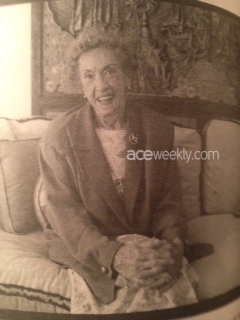9.1.1995 coverstory
Investing in the Arts: Little Goes a Long Way
by Kelly B. Willis
First of all, let’s set the scene. How must a woman — who is a prominent resident in her community, one who controls a great deal of money and who has made unprecedented contributions to that community — how does such a philanthropist live?
Well, I had my ideas. I pictured a sprawling bluegrass mansion where the veranda stays cool even in the dead of July and the bougainvillea are always in season. I mean, that kind of woman doesn’t live just anywhere.
While she doesn’t live “just anywhere,” she also does not live pretentiously. And while she isn’t one to boast, she doesn’t mind telling you about her life if you’d like to listen.
Lucille Caudill Little’s abode is not the most arresting structure on her quiet street in Ashland Park. The garage door was opened when I pulled up to the simple, one-story, stone-veneered structure, a baby-blue Cadillac parked inside. The front door was ajar. I rang the bell several times with no results.


Little will tell you, “Give me center stage and I’ll take it!” Little did have center stage the day we met, not only because I was there to do a profile on her, but because she commands it. Lucille Little, at age 86, has presence. The day I spoke with her, I didn’t ask a single question until I had been there for nearly two hours. She is never at a loss for words or an opinion. And what she has to say is staged right before your eyes as Little calls upon her abilities as an actress, comedienne, and singer to entertain. In many ways, the history of Lucille Little is bound up in the story of our own community and its arts.
For many years, Lucille Little has played a singularly significant role. The spotlight on Little has shone particularly brightly since 1990 when she began making monumental contributions to various arts and non-arts related organizations. Her patronage is in a class by itself, rivaling even corporate donations. But her philanthropy goes well beyond the monetary.
Mrs. Little’s contributions to Lexington’s cultural backdrop began years ago. While her husband, the late W. Paul Little, was amassing a fortune in the horse and tobacco industries in the 40s and 50s, Lucille Little was venturing into the vast wilderness of Lexington’s lost arts heritage.
Once the “Athens of the West,” post-war Lexington had become a lure to the “intellectual average with an emphasis on money and production of things — not people, culture, and art,” says Little.
“At that time, men took care of the business and professional side of life and women were responsible for the cultural side of life.” Little described Lexington as a place where interest had shifted away from fine arts and over to the horse industry. “We all see something different in every situation,” and Little saw a need. She had a vision — a return to the “cultural overlay of a 20s Lexington community.”
Lucille Little rallied to the occasion. “I’d do it myself instead of waiting for or letting someone else do it.” An actress and vocalist by training:
Little became an architect of sorts, rebuilding, renewing and developing an arts community that had lost its focus. She mobilized resources and people, mustering support at both the private and public level. She spent her own money and used her influence to get others to do the same.
After all was said and done, Little had helped in the founding of several arts organization boards including the Lexington Symphony (today’s Lexington Philharmonic), the Youth Symphony, Children’s Theater, the Living Arts and Science Center, and Studio Players. Little was also an actress, playing the lead in the University of Kentucky Guignol Theater’s inaugural production of Medea, and as director of numerous children’s plays.
Little’s work with children was especially rewarding and was the impetus for her continuing interest in the arts and education. “I am the product of a wonderful family,” says Little, a playful smile washing over her face. And thanks to that family, she has an abiding love for music and drama. “I was always wanting to get the singing or acting part in church or school.”
Born in Morehead, Kentucky in 1909, Little describes her hometown as an unprejudiced place with a diverse population. She contrasts this with Lexington at that time, a place where upon first moving here, she felt one associated “only with one’s peers.”
Lucille Little’s father, Daniel Boone Caudill, was a lawyer and a politician. Her mother, Rosetta Proctor Caudill, was the family musician, a wonderful pianist. It was her mother who instilled in Little her passion for music.
From the age of 10 until she was 12 or 13, Little spent her summers at the Cincinnati Conservatory of Music. She studied voice at the university level as well — lots of credits at 11 different colleges. This self-proclaimed “college tramp” has a list of prestigious schools on her transcript including the old, all-female Hamilton College, Transylvania, Stetson University in Florida, Columbia, and the Juilliard School of Music in New York City. “People made me wander around,” says Little who was on the heels of the best voice instructors she could find.
She was the first to receive a fellowship to study music at Ohio University where she eventually earned her undergraduate degree. Later, at Columbia University, she met Milton Smith who would prove to be a great influence on both her own performances and her direction of others’ performances. It was he who taught Little to visualize drama as color and line. In fact, Little wrote her master’s thesis on Smith’s color and line theory, but is unsure as to whether or not she ever earned her master’s degree. And she never attended any graduation ceremony. But she craftily dismisses all of that, saying “What does the record mean? It’s what you can do.”
When her husband died in 1990, she was left with an estate estimated at somewhere between 30 and 36 million dollars. It’s a fortune she has since generously doled out, through her own foundation, to various arts groups and organizations. Little admits she
“didn’t realize there was so much of it until he was gone.”
Her mission: to donate to “education, specifically in fine arts, to develop creativity.” Her emphasis on higher education stemps from her believe that she has “no control over children until they get to college.”
Some of her more recent beneficiaries have included Studio Players, the Lexington Arts and Cultural Council, and the Lexington Philharmonic. The new arts library at the University of Kentucky will bear the names of Little and her late husband. She has also contributed to several non-arts organizations such as Midway college, the Lexington Theological Seminary, and Morehead’s St. Claire Medical Center, namesake of her sister and best friend, Dr. Claire Louise Caudill.
Naturally, with millions of dollars to dispose of, Lucille Little is inundated with a staggering number of requests for money every year. She says not a day has gone by in recent memory when she has not received some kind of solicitation. Her policy is that all requests must be in writing and filtered through her foundation’s board of directors. She also has a policy never to give to individuals, only organizations after they have been fully researched by her or one of her officers.
I asked her what was the strangest financial request she’d ever received. She thought for a minute and said, “well this lady in Richmond [KY] told me if I just gave her $3,000., she could pay all her bills and even take a little trip.”
Little wants all sums she donates, none of which are over a million dollars, to be matched. She will only make a commitment if an organization is willing to meet her half way. “Oh, the organizations I’ve been a part of…” she says, “the muscle, the oil, and grease I’ve poured into them all my life. That’s how I want to be remembered”
Even with the current wave of anti-NEA sentiment gaining momentum in the new congress and the constant setbacks for Lexington’s arts and culture scene, Little remains hopeful. “Get negative — you’re lost and you lose,” she says, although she admits it’s a challenge to always see the glass as half full.
Little has seen the arts pendulum swing from high enthusiasm in the fine arts, to all-out disdain and disinterest, and she believes and hopes it may swing back again. She says Lexington’s proposed cultural center needs more community involvement, as well as follow-through from the city. She says, “I was the only person representing the community [on the first cultural center board] it seemed.”
She credits former mayor Scotty Baesler with being the creative force behind the center, but went on to say “he was full of ideas, but did not follow through on the organization end of it, the planning. There was just a general lack of interest and promotion from the city.
The same could be said of the city that Little says of life in general, “At 86 years old, you ought to have had something happen to you.”









